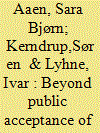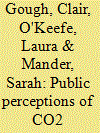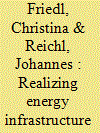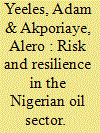|
|
|
Sort Order |
|
|
|
Items / Page
|
|
|
|
|
|
|
| Srl | Item |
| 1 |
ID:
166979


|
|
|
|
|
| Summary/Abstract |
To what extent can energy infrastructure become a tool for insurgents? Non-state, insurgent actors have increased attacks on critical energy infrastructure over time (Giroux et al., 2013). As critical energy infrastructure becomes more complex and interconnected, attacks on this infrastructure can have far reaching consequences not only for the economy but also for social institutions. Leveraging exogenously scheduled elections in Colombia and microlevel energy infrastructure attack data, we use multivariate linear regression to show that insurgent groups, Las Fuerzas Armadas Revolucionarias de Colombia (FARC) and Ejército de Liberación (ELN), time attacks on critical energy infrastructure in the months before an election. We find that the likelihood of an attack on electricity transmission lines and substations increased by 34% in the lead up to election months and that the number of attacks increased by 37% during election months. We further find these attacks are correlated with reduced voter turnout, indicating that infrastructure attacks may undermine participation in democratic institutions. These findings are particularly interesting as democratic societies—burgeoning and established—try to identify the unintended vulnerabilities to society that accompany the benefits of increased interconnectedness.
|
|
|
|
|
|
|
|
|
|
|
|
|
|
|
|
| 2 |
ID:
149992


|
|
|
|
|
| Summary/Abstract |
This article adds to the growing insight into public acceptance by presenting a novel approach to how citizens make sense of new energy infrastructure. We claim that to understand public acceptance, we need to go beyond the current thinking of citizens framed as passive respondents to proposed projects, and instead view infrastructure projects as enacted by citizens in their local settings. We propose a combination of sensemaking theory and actor–network theory that allows insight into how citizens enact entities from experiences and surroundings in order to create meaning and form a reaction to new infrastructure projects. Empirically, we analyze how four citizens make sense of an electricity cable project through a conversation process with a representative from the infrastructure developer. Interestingly, the formal participation process and the materiality of the cable play minor roles in citizens' sensemaking process. We conclude that insight into the way citizens are making sense of energy infrastructure processes can improve and help to overcome shortcomings in the current thinking about public acceptance and public participation.
|
|
|
|
|
|
|
|
|
|
|
|
|
|
|
|
| 3 |
ID:
176913


|
|
|
|
|
| Summary/Abstract |
We study how changes in cross-border energy infrastructure in North America will impact local and national markets. Electricity and natural gas are all transported across the borders of Canada, US, and Mexico. However, future changes in the energy production mix will lead to the further development of these infrastructures, as energy supply and demand cause stress across borders. We use a multimodel approach to investigate what happens to standard output metrics of local energy markets when these infrastructures are changed under different scenarios. These scenarios include increasing the capacity of electricity transmission by 20% and decreasing the cost of transporting natural gas by 20% vis-à-vis the modelers’ reference case starting 2020. We find that electricity transmission across the Canadian-US border increases, with most of the increase in electricity production by natural gas. We also find that natural gas trade increases across the US-Mexico border, with a change in flows of natural gas within the US moving away from the northeast and northwest. While electricity production from renewable energy is expected to increase in the reference scenario, the changes in cross-border energy infrastructure do not significantly impact the generation from renewable energy. The scenarios help identify bottlenecks in the cross-border energy infrastructure, and propose future investment opportunities to decrease overall system costs for producing and consuming energy.
|
|
|
|
|
|
|
|
|
|
|
|
|
|
|
|
| 4 |
ID:
179672


|
|
|
|
|
| Summary/Abstract |
The European Green Deal calls for a revision of the Regulation on guidelines for trans-European energy infrastructure (TEN-E Regulation). The focus of the TEN-E Regulation was on accelerating the development of strategically important projects linking energy networks across the EU, labelled as Projects of Common Interest (PCIs). We provide seven recommendations on how to revise the Regulation to align it with the new full decarbonisation objective. We split the analysis in three parts: the eligibility, selection and cost allocation of PCIs. Regarding eligibility, first, oil networks should be excluded, while the case of gas networks is debatable. Second, power-to-X technologies, electric charging infrastructure and (smart) gas distribution grids could be added to the scope. Regarding selection, first, the Ten-Year Network Development Plan (TYDNP) should be integrated over all energy vectors using an open-source model. Second and third, the scenarios used in the TYNDPs should be subject to the European Commission's approval, while the approval decision for cost-benefit analysis methodologies should be reallocated from the Commission to ACER. Finally, regarding cost allocation, first, cross-border cost allocation decisions should leave all involved jurisdictions with similar benefit-to-cost ratios to increase commitment. Second, affordability should be the only award criterion for European funding.
|
|
|
|
|
|
|
|
|
|
|
|
|
|
|
|
| 5 |
ID:
176714


|
|
|
|
|
| Summary/Abstract |
Existing energy infrastructure have a technical and/or economic lifecycle predetermined by the lifetime of certain components. In energy infrastructure, the residual lifetime of civil structure or other components with a longer life is usually wasted. Modular energy infrastructure can be reconfigurable decoupling the life of the infrastructure from their modules, and extending module and/or infrastructure lifecycle. Modularisation could become a cornerstone to enable circular economy (CE) and enhanced sustainability. Remarkably, despite the growing interest among policymakers, practitioners and academics in both CE and modularisation, there is a lack of knowledge about the link between CE and modularisation in energy infrastructure. Through a Systematic Literature Review, this paper derives the gap in knowledge regarding the link between CE and modularisation in energy infrastructure. This link is then investigated in other sectors identifying relevant implications such as reduction of construction waste and achievement of the closed-loop material cycle. Furthermore, the case of Yamal Liquefied Natural Gas project is used to compare and contrast two perspectives: “Traditional modularisation” and “Modular CE”. Lastly, the paper discusses existing policies, provides policy recommendations to foster “Modular CE” in energy infrastructure and suggests a research agenda.
|
|
|
|
|
|
|
|
|
|
|
|
|
|
|
|
| 6 |
ID:
125655


|
|
|
|
|
| Publication |
2013.
|
| Summary/Abstract |
The ambition of this conference was to deliver a first examination of how policy is delivered in the context of low-carbon energy infrastructure in the UK. The UK has been developing policy in this area since 2002 (Heffron, 2013). Finally, as the decade passed, in November 2012 an Energy Bill was put before the UK Parliament. One of the chief purposes of this Energy Bill is to establish the right environment for new electricity generation infrastructure in the low-carbon sector. There is significant debate on how this will be achieved and, indeed, whether this piece of legislation will actually deliver this outcome. This conference aimed to examine the dynamics of policy delivery. Throughout the day, there was entertaining discussion as a variety of conference presenters provided interesting contributions on how to deliver such policy goals. In total, there were twelve speakers throughout the day representing the UK (University of Oxford, Pinsent Masons Law Firm, University of Stirling, University of Dundee and University of Aberdeen), and also those who provided lessons from abroad from the University of Copenhagen, Central European University, Milieu Ltd., Pillsbury Law Firm (Washington DC, US) and the Conservation Law Foundation (MA, US).
|
|
|
|
|
|
|
|
|
|
|
|
|
|
|
|
| 7 |
ID:
132759


|
|
|
|
|
| Publication |
2014.
|
| Summary/Abstract |
This paper explores the response by members of the lay public to the prospect of an onshore CO2 pipeline through their locality as part of a proposed CCS development and presents results from deliberative Focus Groups held along a proposed pipeline route. Although there is a reasonable level of general knowledge about CO2 across the lay public, understanding of its specific properties is more limited. The main concerns expressed around pipelines focused on five areas: (i) safe operation of the pipeline; (ii) the risks to people, livestock and vegetation arising from the leakage of CO2 from the pipeline; (iii) the innovative and 'first of its kind× nature of the pipeline and the consequent lack of operational CO2 pipelines in the UK to demonstrate the technology; (iv) impacts on coastal erosion at the landfall site; and (v) the potential disruption to local communities during pipeline construction. Participants expressed scepticism over the motivations of CO2 pipeline developers. Trust that the developer will minimise risk during the route selection and subsequent construction, operation and maintenance of the pipeline is key; building trust within the local community requires early engagement processes, tailored to deliver a variety of engagement and information approaches.
|
|
|
|
|
|
|
|
|
|
|
|
|
|
|
|
| 8 |
ID:
150775


|
|
|
|
|
| Summary/Abstract |
The federal state of Upper Austria, at a crossing point for European energy grids, provides large-scale resources for storage of natural gas and is among the top infrastructures in this regard in Europe. Considering the ambitious plans for enhancements of energy infrastructures in this region, the issue of social acceptance of energy infrastructure is crucial. To foster an understanding of the challenges inherent in this issue we present an analysis concentrating on the social acceptance of energy infrastructure projects in Upper Austria. This paper addresses the issues with realizing energy infrastructure projects and analyzes the problems and benefits based on an empirical–qualitative study comprising expert interviews, discussions with stakeholders, and a round table workshop integrating the disparate viewpoints. The aim of the process was to integrate different attitudes, perspectives and positions of relevant stakeholders, members of citizens’ initiatives, environmental organizations and of the national government and local authorities. The results presented are based on both the analysis of the empirical–qualitative data and the existing studies and literature on social acceptance. The qualitative research compares experiences and current practices with social acceptance issues (like frameworks, participation, communication strategies) in a set of considered energy infrastructure projects.
|
|
|
|
|
|
|
|
|
|
|
|
|
|
|
|
| 9 |
ID:
150379


|
|
|
|
|
| Summary/Abstract |
Political unrest in the Niger Delta has long been viewed as a hurdle for extracting maximum value from Nigeria's oil resources. Recently, investors and policymakers have laid blame for sector under-performance on pipeline sabotage and theft, and sounded the alarm for an impending ‘oil crisis’. However, our understanding of the economic effects of social action against oil companies is incomplete. Rigorous analysis has not heretofore been offered as evidence for such dire futures. Despite the obvious risk of pipeline interdiction, price dynamics and aggregate production respond minimally to pipeline interdiction. Based on quantitative analysis of the relationship among price, production and pipeline interdiction from multiple data sources covering different time intervals (monthly data from 2005 to 2014 and annual data from 1999 to 2013), we find no evidence of significant effects of pipeline interdiction on production and a weak relationship between pipeline interdiction and Bonny light crude prices. Reported losses in product are substantial, but there is no evidence of statistically significant impacts on price or production in the aggregate. Explanations for this counterintuitive result are cast in terms of sector resilience. The implications of this finding for producer risk and the likelihood of an impending ‘oil crisis’ are discussed.
|
|
|
|
|
|
|
|
|
|
|
|
|
|
|
|
| 10 |
ID:
175270


|
|
|
|
|
| Summary/Abstract |
The policy of diversification of natural gas supplies requires the extension of appropriate energy infrastructure. The V4 countries consume over 42 bcm natural gas a year. The dominant position in the region is held by the Russian Federation, which supplies the gas to different countries at different prices. Hence, the aim of the paper is to determine what role the Baltic Sea region is going to play for V4 countries as an opportunity to break this dominance. An added value of this article is the identification of the policy factors influencing the strategic importance of the Baltic Sea Region in the context of diversification of energy supply sources. The research hypothesis has been put forward that the development of gas infrastructure in the Baltic Sea Region will have an impact on strengthening the geoeconomic space of the Visegrad Group countries. The author will attempt to answer the following research questions: How should the potential of the Baltic Sea be used to strengthen the energy security of V4 countries? In what way should the gas infrastructure between the Visegrad Group states be developed?
|
|
|
|
|
|
|
|
|
|
|
|
|
|
|
|
| 11 |
ID:
115038


|
|
|
|
|
| Publication |
2012.
|
| Summary/Abstract |
Much has been made about a revival of Mackinderian geopolitics in Eurasia, largely centred on struggles over access to energy resources and rooted in a territorial understanding of space. This paper proposes that the conceptual political cartography of Eurasia is indeed largely being rewritten, but conventional understandings of space, territory, and resources are insufficient in providing insight into a changing geopolitics. We interrogate the geographical logics of Russia's role as energy provider to Europe by focusing specifically on the provision of gas to Europe via Nord Stream, a new underwater pipeline that is scheduled to go online by late 2011. Drawing on debates in human geography on relational/topological views of space, and on the "splintering urbanism" thesis, the paper describes a rapidly evolving networked space that effectively "splinters" the territorial integrity of the region and thereby complicates notions of Eurasian geopolitics that emphasise proximity, territorial hegemony, and state-centric international relations.
|
|
|
|
|
|
|
|
|
|
|
|
|
|
|
|
|
|
|
|
|